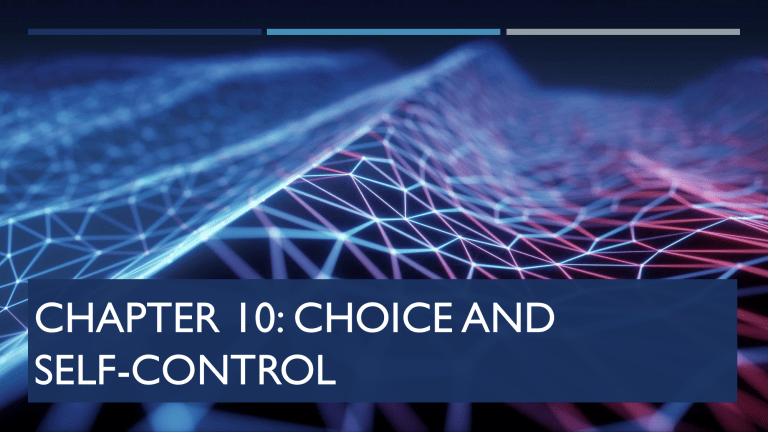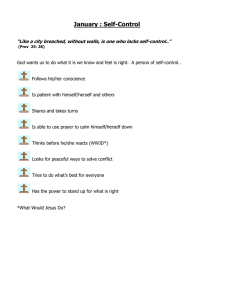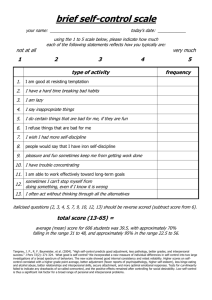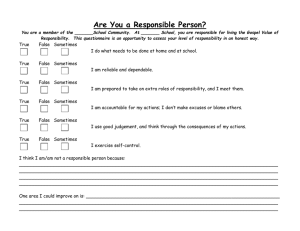
CHAPTER 10: CHOICE AND SELF-CONTROL ALTERNATIVE SOURCES OF REINFORCEMENT In the classroom there are multiple sources of reinforcement and punishment to choose from… The instructor The content The slides Your classmates Doodling Texting Studying for a different class The amount of behavior directed toward an alternative is often proportional to the amount of reinforcement we receive from the alternative CHOICE AND MATCHING Concurrent Schedules A concurrent schedule of reinforcement consists of the simultaneous presentation of two or more independent schedules, each leading to a reinforcer.The organism thus has a choice between responding on one schedule or the other. VR 500 VI 1 hour VR 1000 VI 2 hours THE MATCHING LAW Matching law: proportion of responses emitted on a schedule matches the proportion of reinforcers on that schedule Ex 1: a person will emit approximately twice as many responses on the VI 30-minute schedule as on the VI 60-minute schedule because the rate of reinforcement on the former will be twice as great as on the latter NOTE: Do NOT need to know the formula for the Matching Law, Deviations from Matching, or Matching and Melioration (p. 375-382) SELF-CONTROL A person who behaves wisely and resists temptations is said to have a lot of willpower, whereas a person who behaves poorly and yields to temptations is said to have little willpower. So what is “will power”? SKINNER ON SELF-CONTROL Skinner didn’t view self-control as an issue of willpower, but as an issue of conflicting outcomes. Ex: drinking alcohol can lead to both positive & negative outcomes. Skinner also proposed that managing this conflict involves two types of responses: a controlling response which alters the frequency of a controlled response. So, one impacts the other. SKINNER ON SELF-CONTROL Skinner listed several types of controlling responses Physical Restraint- person physically manipulates the environment to prevent the occurrence of a behavior (ex: leaving money at home so you will spend less) MEANS RESTRICTION AS SUICIDE PREVENTION SKINNER ON SELF-CONTROL Skinner listed several types of controlling responses Depriving & Satiating- utilize the motivating operations of deprivation and satiation to alter the strength of a reinforcer (ex: eat before going grocery shopping) Doing Something Else- Performance of an alternate behavior (example: smokers may depend on gum or sunflower seeds while trying to quit) SKINNER ON SELF-CONTROL Skinner listed several types of controlling responses Self-Reinforcement & Self-Punishment- reinforce one’s own behavior. People often don’t do this effectively – will provide reinforcer even when behavior not completed; will fail to provider punisher SELF-CONTROL AS A TEMPORAL ISSUE From a temporal perspective, lack of self-control arises from the fact that our behavior is more heavily influenced by immediate consequences than by delayed consequences SELF-CONTROL AS A TEMPORAL ISSUE A person can have an affair tonight (a relatively immediate reward) or go home alone in the hopes of maintaining their relationship (a relatively delayed reward). In a simple choice between having a fun evening and a successful marriage, they would choose the marriage. But the affair is immediately available (and powerful), thus very tempting. SELF-CONTROL Self-control: ability to inhibit one’s impulses, emotions, and behaviors to achieve long-term goals Choice between a small, immediate reinforcer and a larger, delayed reinforcer AMBIVALENCE Motivational Interviewing: A counseling style for eliciting behavior change by helping clients to explore and resolve ambivalence. Immediate Consequence (Certain) Delayed Consequence (Uncertain) Stay in course Anxiety, have to work hard Might pass – graduate on time Might fail – negatively impact GPA; could impact job prospects; might need to retake, delay graduation Drop course Reduce anxiety, can focus on other things/classes GPA stays the same Need to figure out degree plan – might delay graduate Retake course – might F anyway https://youtu.be/QX_oy9614HQ MISCHEL’S DELAY OF GRATIFICATION PARADIGM Delay of Gratification–choosing a larger later reward over smaller sooner reward Impulsiveness–choosing smaller sooner over larger later reward Question: what sorts of strategies children might use to wait out the delay period and obtain the larger reward? Ex: a common strategy was to avert their eyes or cover their eyes with their hands. Also “doing something else,” like talking or singing to themselves. Thus, resistance to temptation was enhanced by not attending to the reward. Follow-up evaluations found that the children who were better at this self control could cope well with frustrations, were academically proficient, and got along well with their peers. THE AINSLIE–RACHLIN MODEL OF SELFCONTROL Ainslie-Rachlin model: the value of a reward is a hyperbolic function of its delay AKA The value of a reward increases more and more as the attainment of the reward becomes more imminent (or as delay decreases) THE AINSLIE–RACHLIN MODEL OF SELFCONTROL Ainslie–Rachlin Model of Self-Control- preference between smaller sooner and larger later rewards can shift over time. 8:00 AM 11:30 AM THE AINSLIE–RACHLIN MODEL OF SELFCONTROL THE AINSLIE–RACHLIN MODEL OF SELFCONTROL 1.5 pts later 0.5 pts now DELAY DISCOUNTING Delay discounting: The strength/value of a reinforcer decreases as its delay increases This is a restating of the Ainslie-Rachlin model Behavioral economics Faster delay discounting for younger people, smokers, drug/alcohol addiction, pathological gamblers – people highly disinhibited THE AINSLIE–RACHLIN MODEL OF SELFCONTROL https://youtu.be/1nBwfZZvjKo SEVERAL VARIABLES CAN AFFECT THE SHAPE OF A DELAY FUNCTION Innate differences in impulsivity across species Individual differences in impulsivity Less impulsivity when older Less impulsivity after experience SEVERAL VARIABLES CAN AFFECT THE SHAPE OF A DELAY FUNCTION Availability of other reinforcement reduces impulsiveness Lack of reinforcement (depression) = more impulsive decisions Maintain responding for distant goal by setting up explicit series of subgoals If you wanted to start working out 4 days per week, what are sub- goals you would set up? Making a Commitment (Precommitment) Response Carried out at early point in time Serves either to eliminate or greatly reduce the value of upcoming temptation SMALL-BUT-CUMULATIVE EFFECTS MODEL Each individual choice on self-control task has small but cumulative effect on our likelihood of obtaining desired long-term outcome; helps explain why self-control is difficult Example = “Hey, it’s been a tough day, so why not indulge just this once?” To improve self-control: Make salient that individual choices are not isolated events, but rather parts of a whole Have a relapse prevention plan Establish rules that clearly distinguish between acceptable and unacceptable behaviors


